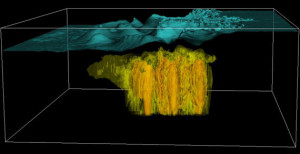Single-cell genomics unravels a microbial species’ role in breaking down hydrocarbons.
The Science:
Researchers sequenced and analyzed a single cell of Colwellia bacteria to understand why these microbes were predominant in the Gulf of Mexico after the Deepwater Horizon oil spill.

Simulation of oil plume equilibrating at mid-depth of the ocean domain. (Tamay Ozgokmen, University of Miami; Paul Fischer and Aleks Obabko, Argonne National Laboratory; and Hank Childs, Lawrence Livermore National Laboratory via Flickr CC BY-NC-SA 2.0)
The Impact:
Understanding the characteristics of the Colwellia bacteria furthers the researchers understanding of the particular roles microbes played in degrading the oil plume during the Deepwater Horizon oil spill.
Summary
In response to the oil spill from the Deepwater Horizon oil rig in the Gulf of Mexico four years ago, various microbial communities helped disperse the hydrocarbons. At the time, researchers from Lawrence Berkeley National Laboratory (Berkeley Lab) collected samples at the site, and with assistance from researchers at the U.S. Department of Energy Joint Genome Institute (DOE JGI), they studied the microbial community’s expressed functional information or metatranscriptome, and also isolated single cells to identify the predominant microbial members in the deep ocean oil plume.
Olivia Mason of Florida State University, formerly a postdoctoral fellow with Berkeley Lab microbiologist Janet Jansson, has continued exploring the microbial communities that responded to the Deepwater Horizon oil spill. In a Frontiers in Microbiology paper published July 8, 2014, she re-teams with Jansson and DOE JGI researchers, to examine Colwellia bacteria, which was the second group to become predominant in the Gulf of Mexico microbial community surrounding the oil plume. (The first was Oceanospirillales, which degraded certain non-gaseous hydrocarbons. Colwellia then degraded the gaseous and simple aromatic hydrocarbons.) “Few detailed descriptions of the cellular physiology of the indigenous microbes that responded to the hydrocarbon inputs have been presented,” the researchers wrote in explaining the focus of their work.
For the study, the genome of a single cell of Colwellia bacteria collected from 1,200 meters below sea level was amplified, sequenced, assembled, and analyzed. This single amplified genome (SAG) was then compared against that of a cultured Colwellia strain isolated from the Arctic, and other Colwellia strains found in the oil plume. One of the questions researchers wanted to answer through the analyses was how the Colwellia bacteria in the Gulf of Mexico were able to break down polycyclic aromatic hydrocarbons such as benzene and propane when the cultured strain had shown no indication of being able to degrade hydrocarbons at all. They found part of their answer in the fact that the Colwellia SAG contains genes that are involved in degrading volatile organic compounds such as benzene, toluene, ethylbenzene, and xylenes.
Contact
Janet Jansson
Lawrence Berkeley National Laboratory
[email protected]
Funding
- U.S. Department of Energy Office of Science; University of California at Berkeley, Energy Biosciences Institute (EBI).
Publication
Mason OU et al. Single-cell genomics reveals features of a Colwellia species that was dominant during the Deepwater Horizon oil spill. Front. Microbiol. 2014 July 07;(5):332. doi: 10.3389/fmicb.2014.00332